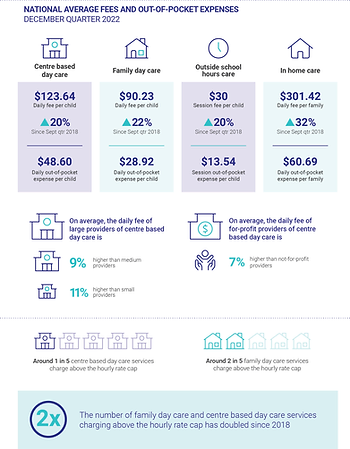Key Points:
- Rising Childcare Costs: Childcare fees have surged over the past four years, outpacing inflation and wage growth, with a 20% to 32% increase across different care types.
- Government Subsidies: While government subsidies help, out-of-pocket expenses for households have risen, particularly for centre-based daycare, outside-school-hours care, and family daycare.
- Income Disparity: Despite government contributions, low-income households feel the childcare cost burden the most, spending a significant portion of their disposable income.
- Complex Pricing Dynamics: Unlike some markets, childcare prices in an area tend to rise as the number of providers increases, as parents prioritise factors like location and quality over price.
- Future Changes: Significant changes to the Child Care Subsidy and hourly rate cap will take effect in July 2023, potentially impacting household expenses and provider fees.

Childcare services in Australia are a lifeline for over a million families, but the latest interim report from the Australian Competition and Consumer Commission (ACCC) reveals a complex landscape of rising costs and accessibility challenges. Let’s dive into the essential findings and their implications.
In this article, we delve into the pivotal aspects of the imminent reforms and their potential ramifications on the childcare industry. Additionally, we spotlight the role of HCPA in assisting providers to navigate those transformative changes effectively.
Childcare Costs on the Rise
The ACCC’s comprehensive analysis confirms what many parents feel: childcare fees have increased faster than inflation and wage growth over the past four years. This increase has been particularly notable for in-home care, with a staggering 32% surge. Even with government subsidies, out-of-pocket expenses have risen by 7% for centre-based daycare, 12% for outside school hours care, and 15.8% for family daycare.
Impact on Disadvantaged Households
A concerning aspect highlighted by the report is that disadvantaged households disproportionately feel the cost burden. Despite receiving greater government contributions and lower out-of-pocket expenses, half of low-income households spend between 5% and 21% of their disposable income on childcare. In contrast, higher-income households allocate 2% to 9% of their disposable income to childcare. This discrepancy raises questions about equity and access.
Localised Pricing Dynamics
Unlike many markets, childcare services exhibit localised pricing dynamics. When more childcare providers are in an area, prices tend to rise. This suggests that parents prioritise location and quality over price when making childcare decisions. Additionally, the report reveals that larger, for-profit, centre-based daycare providers charge higher fees than their not-for-profit counterparts.
Upcoming Changes and Their Implications
Major changes to the Child Care Subsidy and hourly rate cap are on the horizon, set to take effect on July 10, 2023. These changes, including an increase in the maximum subsidy rate from 85% to 90%, are expected to impact household expenses and provider fees. They represent a significant shift in the childcare landscape and require careful monitoring and adaptation.
HCPA: Your Partner in Navigating Changes
As childcare providers face these impending changes, HCPA plays a crucial role in offering support and guidance. We specialise in assisting childcare providers to navigate the evolving landscape effectively. HCPA handles everything from start to finish, so you won’t have to go through the complexities alone. Our experts are here to help you through every step of the way.
Regional Disparities
While there has been a 17% increase in approved childcare places between 2018 and 2022, this growth is uneven across the country. Metropolitan and regional areas have seen a rise in childcare services, while family daycare and in-home care services are dwindling. These disparities in service availability contribute to substantial differences in fees, options, and service quality based on location and income.
Affordability vs. Quality
Affordability is the primary consideration for parents when determining the extent of formal childcare use. Out-of-pocket expenses significantly influence these decisions. However, once families ascertain their childcare needs and budget, other factors like location, availability, safety, and quality precede their choice of childcare provider.
What’s Next?
The ACCC’s inquiry into childcare services is far from over. A consultation paper is slated for release in September 2023, which will delve into the cost of childcare services and other relevant issues outlined in the terms of reference. Stakeholders will be invited to contribute their insights and recommendations, with a final report expected to land on the Treasurer’s desk by December 31, 2023.
In conclusion, the ACCC’s interim report on childcare services in Australia highlights the complexities of an essential sector facing rising costs and accessibility challenges. At HCPA, we recognise the importance of delivering high-quality care. As the inquiry progresses, policymakers, childcare providers, and stakeholders must work together to ensure that high-quality childcare remains accessible and affordable to all Australian families, regardless of location or income level.
HCPA is an all-in-one solution for childcare providers, supporting them with registration, growth and consulting. Contact us now here or call 03 9084 7472 to learn how we can help you succeed.
SOURCES | ACCC ‘Pricing practices and operating costs of childcare services to be examined, as latest ACCC report confirms fees outpaced inflation’ |





